|
The 2010 Stereoscopic Displays and Applications was another great event. The photos on this page illustrate some of the various events and happenings at the conference.
Keynote
This year's keynote presentation was delivered by Bob Whitehill from Pixar. His presentation on "Three-dimensional storytelling" described the ways in which Pixar uses 3D as a visual storytelling device, analogous to their use of color, composition, and movement.

[K1] Bob Whitehill and Audience during the keynote presentation.
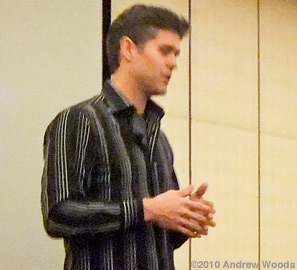
[K2] Bob Whitehill from Pixar during the keynote presentation.
Technical Presentations
The technical presentations form the backbone of the SD&A conference and there was a wealth of interesting topics to experience this year. Here are some of the technical authors in action:

[T1]Panorama of question time at one of the technical talks chaired by Mike Weissman
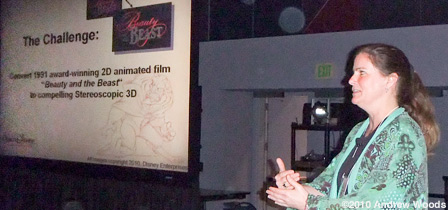
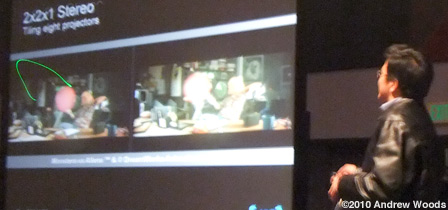
[T2] Tara Turner from Disney Feature Animation disussed the stereoscopic technologies being used for the conversion of Beauty and the Beast into 3D.
[T3] Nelson Chang from HP Labs discussed a multiprojector scalable 3D display.
Discussion Forums
Two discussion forums were held at the 2010 SD&A conference. The first was titled "3D Video Standards - At Last!!"
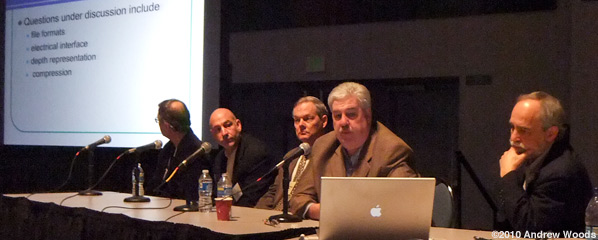

[F1, F2] The forum in full swing. (left to right):
Mark Stockfisch (Consumer Electronics Association and Quantum Data, Inc.), Steve Venuti (HDMI LLC), David Broberg (Society of Cable Telecommunications Engineers and CableLabs), Pete Ludé (SMPTE and Sony Electronics), and Mike Weissman (TrueVision Systems).
The second discussion forum was titled "The Business of 3D: How to Build Successful Business Models".
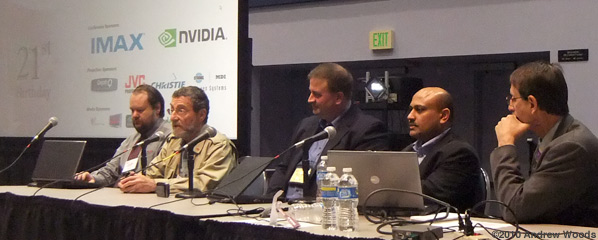 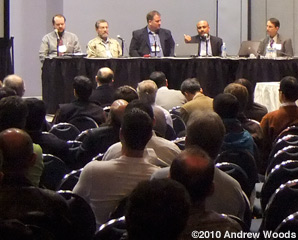
[F3][F4] Deep in discussion. (left to right):
Chris Ward (Lightspeed Design, Inc.), Lenny Lipton (Oculus3D), Jim Calverley (FujiFilm USA), Sunil Jain (Intel Corp.), and Chris Chinnock (Insight Media)
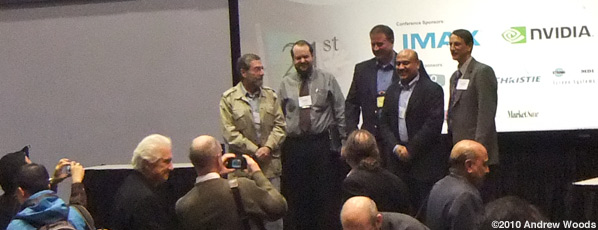
[F5] a post forum photo opportunity.
3D Cameras Everywhere
There were lots of 3D cameras in the hands of attendees again this year. The new FujiFilm 3D camera was by far the most popular 3D camera with attendees.

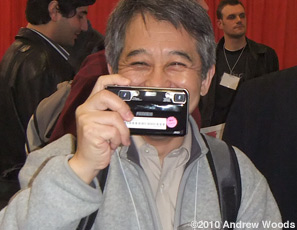 [C1] A bank of FujiFilm 3D cameras: Bernard Mendiburu, Takashi Kawai (Waseda University), Ray Zone (The 3D Zone), Mikko Kytö (Helsinki University of Technology), Michael Brauss (Proto Manufacturing), Andrew Woods (Curtin University).
[C1] A bank of FujiFilm 3D cameras: Bernard Mendiburu, Takashi Kawai (Waseda University), Ray Zone (The 3D Zone), Mikko Kytö (Helsinki University of Technology), Michael Brauss (Proto Manufacturing), Andrew Woods (Curtin University).
[C2] Tomio Sonehara (Epson) with another FujiFilm 3D camera.
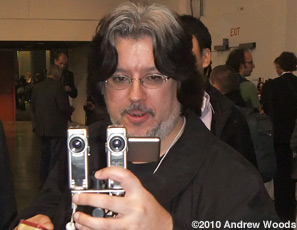
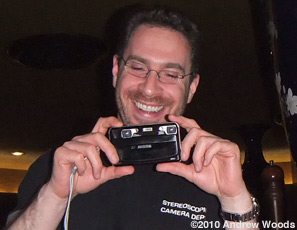
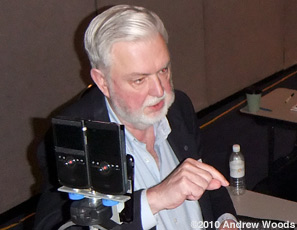 [C3] Eric Kurland with a Canon TX1 3D rig using StereoData Maker
[C3] Eric Kurland with a Canon TX1 3D rig using StereoData Maker
[C4] Jason Goodman (21st Century 3D) with yet another FujiFilm 3D camera.
[C5] Chuck Colby with a a 3D pair of Kodak still/video cameras.
And of course if you have a 3D camera, you also need a 3d viewer...
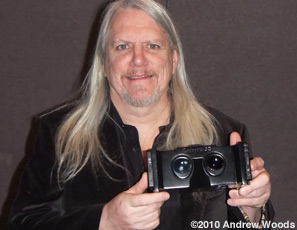
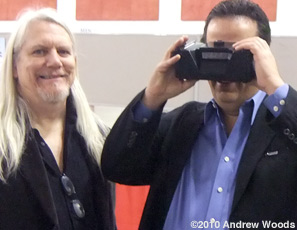
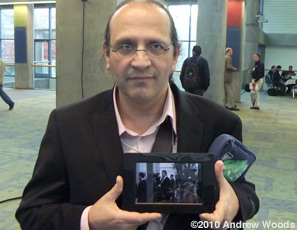 [C6] Ken Burgess and the Cyclopital3D viewer.
[C6] Ken Burgess and the Cyclopital3D viewer.
[C7] Ken Burgess with an SD&A attendee putting the Cyclopital3D viewer through its paces.
[C8] Luis Perez-Bayas with a 3D digital photo frame showing some 3D wedding footage.
People


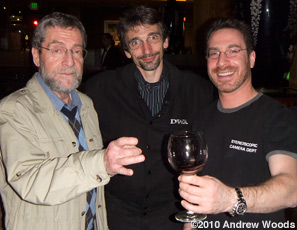
[P1] Justus Ilgner (University Hospital Aachen) and Takashi Kawai (Waseda University)
[P2] Nick Holliman (Durham University) and David McAllister (North Carolina State University)
[P3] Lenny Lipton (Oculus 3D), Bernard Mendiburu and Jason Goodman (21st Century 3D)
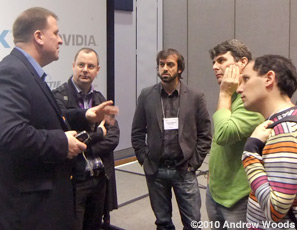
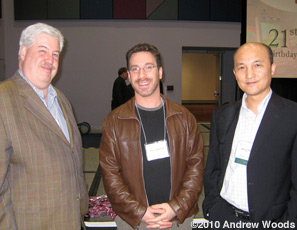
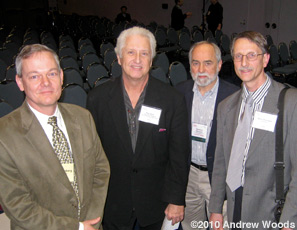
[P4] conference attendees listen to Jim Calverley (FujiFilm) after the discussion forum
[P5] Pete Ludé (Sony), Jason Goodman, Samuel Zhou (IMAX)
[P6] David Broberg (CableLabs), Ray Zone (The 3D Zone), Mike Weissman (True Vision Systems), Chris Chinnock (Insight Media)
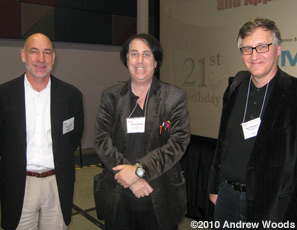
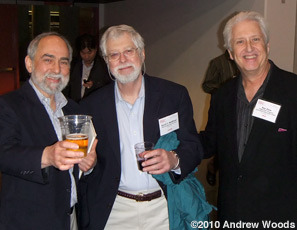
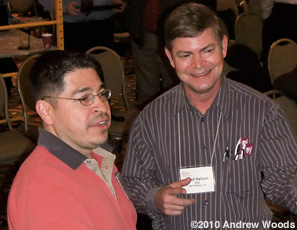
[P7] Steve Venuti (HDMI), David Mark (PLLX3), Mark Stockfisch (Quantum Data)
[P8] Mike Weissman, David McAllister and Ray Zone
[P9] Adrian Romero (Spectrum AV), Brad Nelson (PLLX3)
Prizes
A total of four prizes were offered at the SD&A conference for various achievements.
Two prizes were offered for the best use of the stereoscopic projection tools during the technical presentations.
The two winners were:
(1) Tara H. Turner (Walt Disney Animation Studios) for "Beauty and the Beast: from 2D to 3D" which discussed stereoscopic viewing systems for stereoscopic movie production, and presented previews of the 2D to 3D conversion work done on the movie Beauty and the Beast; and
(2) Justus Ilgner (Aachen University Hospital) for "What every surgeon wants: practical aspects on the use of stereoscopic applications in operative theatres" which included videos of surgery and stereoscopic still images of the stereoscopic equipment in situ in his operating theatres.
A further two prizes were offered to recognize high quality 3D content shown at the 3D Theatre session.
The two winning titles were:
(1) Best of Show (Computer Graphics -- non-theatrical): "Cosmic Origins" by Durham University (United Kingdom); and
(2) Best of Show (Live Action -- non-theatrical): "The Caretaker 3D," Produced by Jeff Amaral , directed by Sean Isroelit, filmed by Allen Daviau ASC, using 3Ality Digital's TS 2 stereoscopic camera (United States).
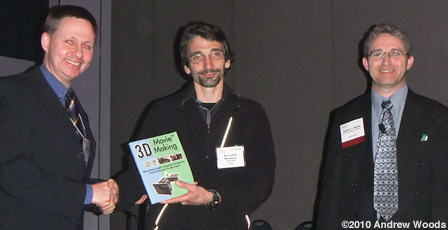
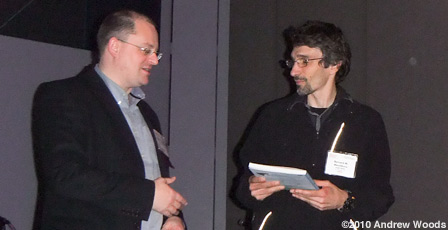
[PR1] Shown here is Justus Ilnger receiving his prize from Bernard Mendiburu and Andrew Woods.
[PR2] Shown here is Nick Holliman receiving the prize for "Cosmis Origins".
All of the prizes were signed copies of Bernard Mendiburu's book, 3D Movie Making: Stereoscopic Digital Cinema from Script to Screen, presented personally by the author and kindly donated by the publisher.
3D Theatre
Once again the 3D Theatre was a very popular session and some great 3D content was on show.

[TH1] The eager audience just before the 3D Theatre session started.
The full list of content show during the 3D Theatre session is listed in conference proceedings introduction.
Round Table Discussions
During the SD&A conference several lunch-time round-table discussions were held. These were a chance for people to chat about various chosen 3D themes.
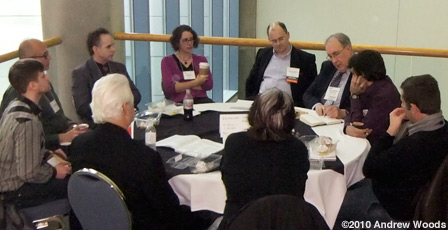
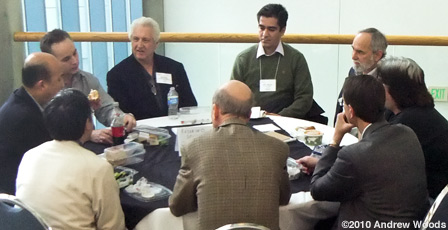
[RT1] Participants in Monday's lunch-time round-table discussion;
[RT2] Participants in Tuesday's lunch-time round-table discussion.
Equipment
The ability to present high-quality large-screen stereoscopic images and video at the conference is vital to the conference's success.
This year we had two stereoscopic projection systems setup across two rooms.
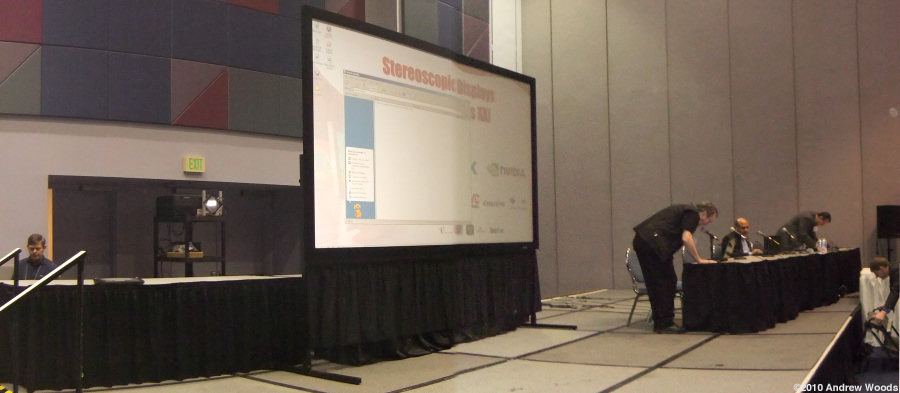
[E1] In the main SD&A conference room we had a Christie Digital 'HD6K' projector (1920x1080 resolution, 16:9 aspect ratio, 3 chip DLP) (provided by Christie Digital) projecting onto a new 10.7x6 foot rear-screen (provided by Brad Nelson) outputting frame-sequential polarized 3D (at 120Hz) by way of a DepthQ active polarization modulator (provided by DepthQ Stereoscopic).
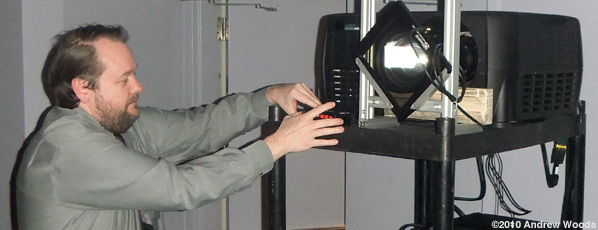
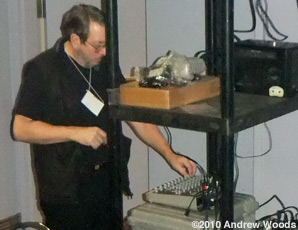
[E2] Chris Ward setting up the DepthQ modulator on the Christie 'HD6K' projector.
[E3] Stephan Keith setting audio levels in the main SD&A conference room.
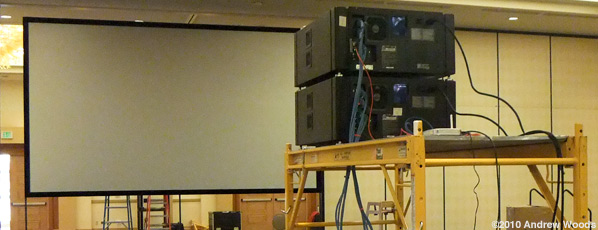
[E4] A second, larger stereoscopic projection system was setup in the large ballroom of the Marriott Hotel for the Keynote presentation and 3D Theatre session. This system consisted of a pair of JVC 'DLA-SH4KG' projectors (4K resolution per projector (4096 x 2400 pixels), 16:9 aspect ratio, three panel LCoS) (provided by JVC Professional) projecting onto a new 16x9 foot silvered screen (provided by Strong / MDI Screen Systems). Both stereoscopic projection systems were each driven by DepthQ stereoscopic media servers (one for each stereoscopic projection system) for playback of all of the stereoscopic video content shown during the 3D Theatre (except 4K 3D content) and in the main SD&A conference room. The 4K 3D content on the JVC 4K projector was served by a Doremi 'DSV-J2' special venue player and two Doremi 'MB-4K' playback processors (provided by Doremi Labs and JVC Professional).
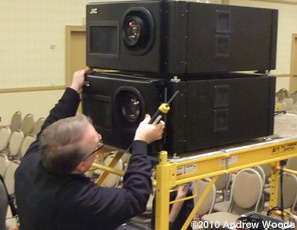
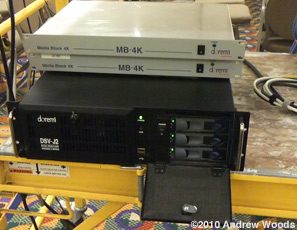
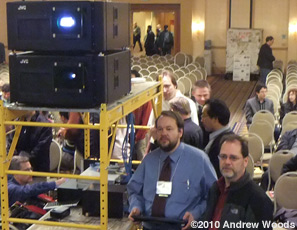
[E5] Rod Sterling setting up the twin JVC 4K projectors.
[E6] The Doremi Labs cinema server and formatter boxes used as part of the 3D projection system
[E7] Chris Ward and Bob Mueller check the DepthQ Player playlist.
This year's setup was particularly complicated and risky. Many thanks for a for a job done extremely well go to: Chris Ward, Bob Mueller, and Dan Lawrence from DepthQ Stereoscopic; Rod Sterling from JVC Professional; Wayne Bickley from Christie Digital; Fran¨ois Barrette from Strong / MDI Screen Systems; Adrian Romero and staff from Spectrum Audio Visual; Ron Williams from Doremi Labs; Diana Gonzalez from IS&T; and Brad Nelson. The AV setup was project managed by Andrew Woods.
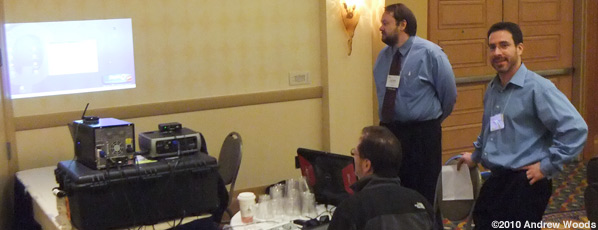
[E8] Bob Mueller and Chris Ward setup an impromptu 3D editing suite in the back of the ballroom using a portable DepthQ projector.
Short Course
John Merritt and Andrew Woods taught the successful short course on Stereoscopic Display Application Issues the Sunday before the conference.
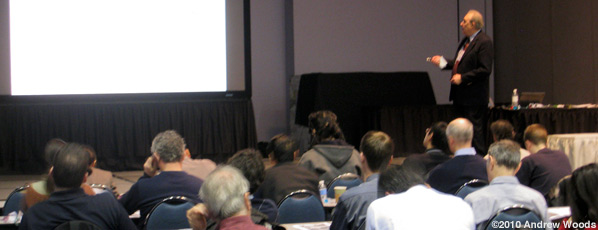
[SC1] John Merritt describes stereoscopic concepts to the studious audience.
Electronic Imaging Reception
The Electronic Imaging All-Conference Reception is always a good opportunity to mingle and chat with new acquaintances and good friends.
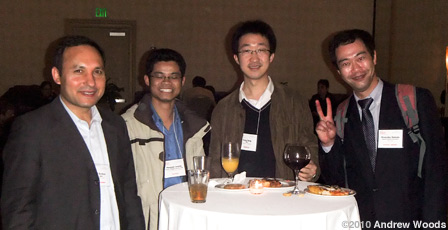
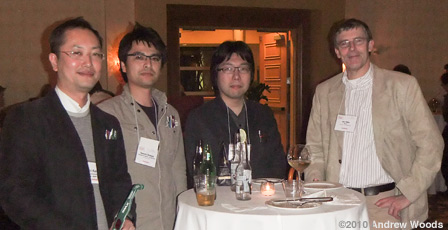
[R1] Sabri Gurbuz (NICT), Pongsak Lasang (Panasonic), Feng Yang (EPFL), Hironobu Gotoda (National Institute of Informatics)
[R2] Takasi Kawai (Waseda University), Takashi Shibata (Waseda University), ????, Jan Klijn.

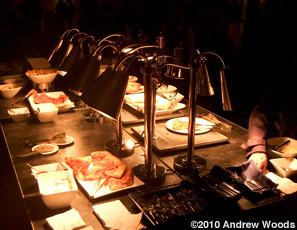
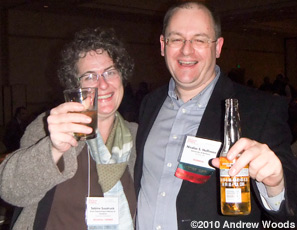
[R3] Masayuki Fukuzawa (Kyoto Institute of Technology), ????, Hideki Kakeya (University of Tsukuba) experience a 3D business card.
[R4] Everyone was fed...
[R5] ... and watered. Sabine Susstrunk (Ecole Polytechnique Fédérale de Lausanne) and Nick Holliman (University of Durham).
A 3D gaming demonstration was setup during the Wednesday night Electronic Imaging Reception. Ben Chang setup a large screen polarized stereoscopic projection system running a 3D game version of Scalable City from Sheldon Brown.
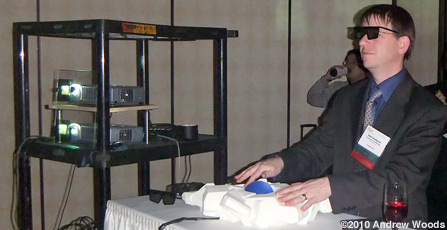
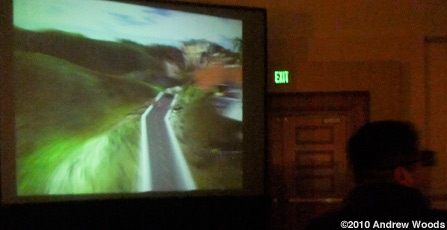
[R6] Neil Dodgson (University of Cambridge) experiences the 3D projected game.
[R7] A brief view of the 3D game projection.
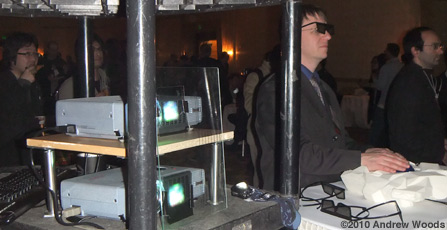

[R8] projected in polarised 3D using a pair of Eiki projectors.
[R9] more reception attendees experience the 3D Scalable City game.
See also:
- The Demonstration Session
All photographs © 2010 Andrew Woods.
Higher resolution and 3D images available upon request.
|












 [C1] A bank of FujiFilm 3D cameras: Bernard Mendiburu, Takashi Kawai (Waseda University), Ray Zone (The 3D Zone), Mikko Kytö (Helsinki University of Technology), Michael Brauss (Proto Manufacturing), Andrew Woods (Curtin University).
[C1] A bank of FujiFilm 3D cameras: Bernard Mendiburu, Takashi Kawai (Waseda University), Ray Zone (The 3D Zone), Mikko Kytö (Helsinki University of Technology), Michael Brauss (Proto Manufacturing), Andrew Woods (Curtin University).

 [C3] Eric Kurland with a Canon TX1 3D rig using StereoData Maker
[C3] Eric Kurland with a Canon TX1 3D rig using StereoData Maker

 [C6] Ken Burgess and the Cyclopital3D viewer.
[C6] Ken Burgess and the Cyclopital3D viewer.































